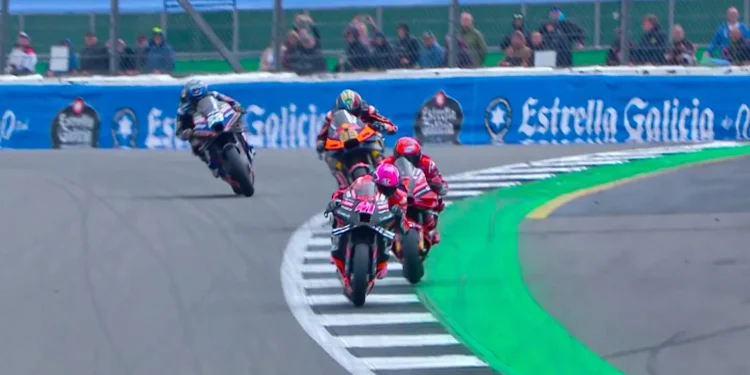Track limits have generated controversy in MotoGP recently, often affecting the outcome of a race. However, there is a rigorous system in place to define and enforce track limit rules. Here’s a detailed look at how it works.
The Basic Rule
During practice or qualifying sessions, if a rider exceeds track limits and enters the green painted areas, their lap time is automatically canceled. In races, where the final classification is based on the finishing order and not lap times, penalties are applied to reflect infractions. These run-off areas are designed for rider safety, so occasional errors, without a clear gain in advantage, are allowed. Additionally, riders receive a warning before any penalty.
In Sprint races – exclusive to MotoGP – three track limit infringements result in a Long Lap penalty. This happened to Brad Binder (Red Bull KTM Factory Racing) at Assen (in 2023), where a third off-track excursion, the third excess on the last lap, automatically resulted in a Long Lap and not because it was the last lap itself. In MotoGP, Moto2, and Moto3 Grand Prix races, five track limit infringements are allowed before a rider is penalized with a Long Lap. The timing of the penalty may vary, depending on when the fifth infringement occurs.
The Last Lap
The last lap is a special case, as it can be decisive for the final result. Here, the context is fundamental as explained in the rules.
If a rider goes off track but is clearly ahead of the closest competitor, this does not automatically result in a loss of position. However, if the race is close and the rider behind is within a distance considered “dangerous” by Race Direction, the infringing rider will be penalized with a loss of one position.
Once again, Brad Binder is an example due to what happened in 2023 at Assen: In the Sunday race, he was penalized for going off track on the last lap while Aleix Espargaró (Aprilia Racing) was close enough to be favored by the stewards’ decision.
How are infringements detected?
Sensors have been installed in the most likely locations for infringements to monitor the limits. However, not all points have sensors, and cameras have been installed in some more complex areas or in Long Lap penalty zones.
Looking back at 2023 – a year in which all decisions were made and then explained – an example is the incident of Francesco Bagnaia (Ducati Lenovo Team) on the last lap of the British Grand Prix. The images caused some discussion, but trackside sensors at Silverstone confirmed that Bagnaia did not go off track, not triggering the sensors. In this case, the stewards rely exclusively on the sensor readings, without human intervention.
However, in areas without sensors, such as the Long Lap in Assen, the decision is made based on images captured by specific cameras, with the final decision being up to the MotoGP stewards. For a penalty to be applied, there must be clear and indisputable evidence of the infringement.







